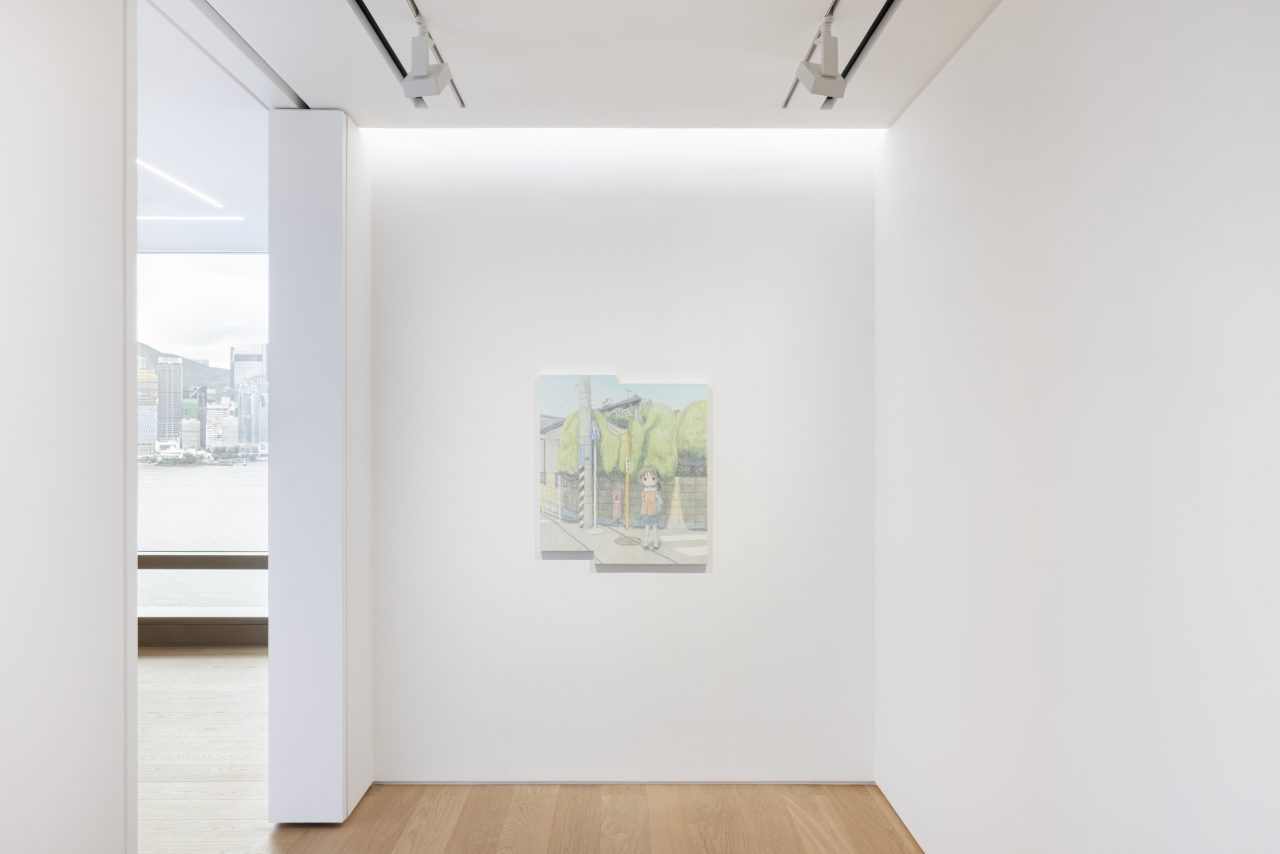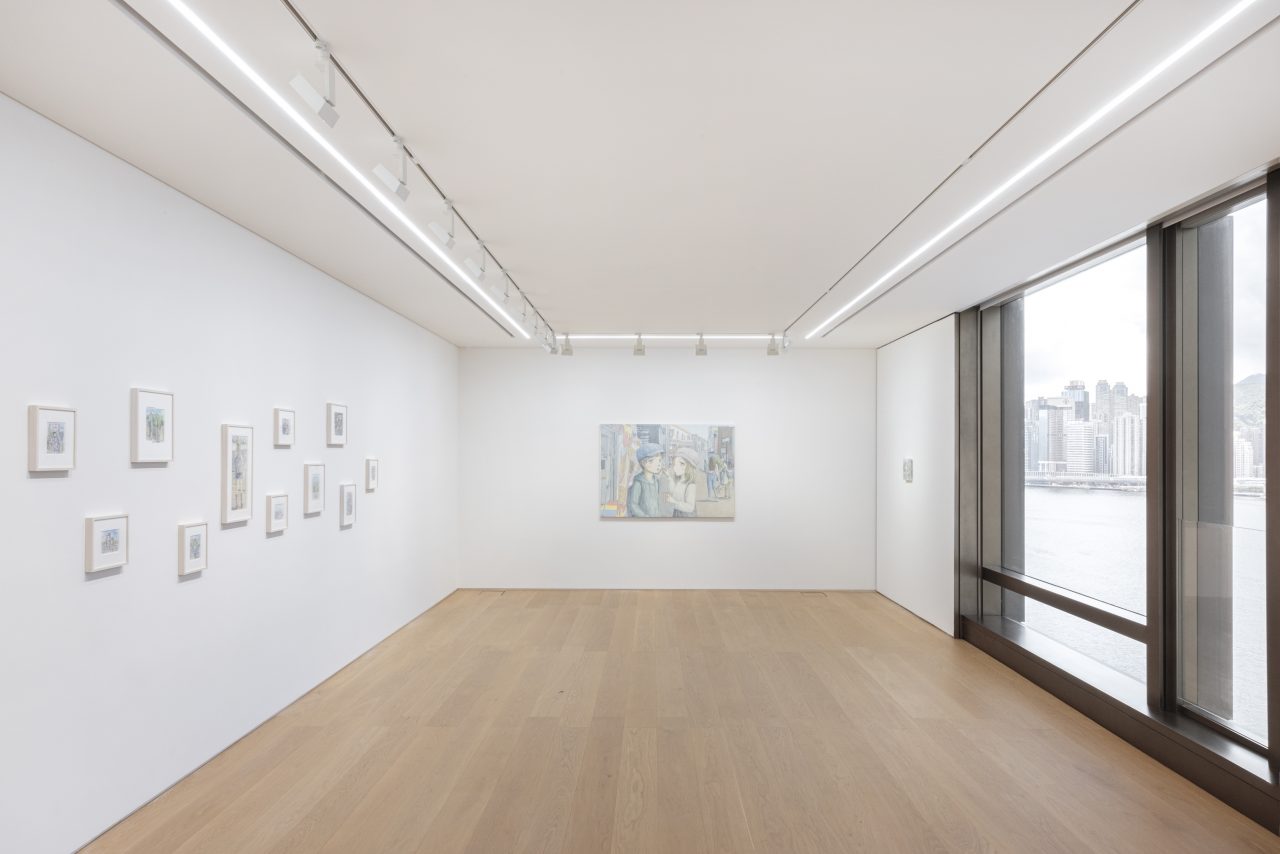When I walked into Perrotin Gallery, I was greeted by a myriad of young faces on canvases. Bashful. Defiant. Radiant. These are the faces that make up Japanese artist Emi Kuraya’s first solo exhibition in Hong Kong, Girl’s Time, which explores what it means to be a young woman in the modern day. Under Kuraya’s deft brush strokes, the transient beauty of teenagedom is immortalised in a series of portraits awash in soft pastels. “The teenage years only go by once in a lifetime,” she muses nostalgically, “it is so precious.”
In 2018, while still a student at Tokyo’s Tama Art University, Kuraya was invited to join Takashi Murakami’s art society Kaikai Kiki, which includes the likes of Virgil Abloh and Hong Kong’s very own Kasing Lung. Kuraya distinguishes herself through her nuanced portrayal of female figures as they navigate the liminal space between adolescence and adulthood, a time that resonates deeply with her own experiences. “I believe the complex feelings I want to express in my art are most strongly manifested during the sensitive teenage years,” she explains. Her paintings delve into the heart of this transformative period, capturing moments of vulnerability, growth, and self-discovery — a rite of passage experienced by women everywhere, who serve as Kuraya’s main source of inspiration. “The sources for the female figures I draw exist everywhere in daily life, including close friends, anime characters, selfies on social media, and people I pass by on the street. Among these, characters from anime are particularly vivid and memorable as visuals for me,” she reveals.

Views of Emi Kuraya’s exhibition at Perrotin Hong Kong, 2024 Photo: Ringo Cheung ©2024 Emi Kuraya/Kaikai Kiki Co., Ltd. All Rights Reserved. Courtesy Perrotin
For those who have seen her work, it is clear Kuraya’s artistic journey is heavily influenced by anime and manga. She grew up leaping in between the vibrant worlds of Pokémon, Toradora, K-On! , Studio Ghibli and more. “I never imagined I would become an oil painter,” Kuraya admitted. “Throughout my elementary and middle school years, I always dreamed of becoming an animator. The cover illustrations of popular anime magazines served as my sketching models.”
Before oil painting, Kuraya’s first love was sketching. As a girl, she filled notebooks full of line art. “Sketching is as familiar to me as writing in a diary,” she smiles. Now, traces of her raw pencil sketches can be spotted in her paintings. Kuraya’s paper sketches are also on display in Perrotin, allowing us to see how Kuraya brings her line drawings to life with her paintbrush.
Through her paintings and sketches, Kuraya invites us to see the world through her lens, literally. Her artwork is often based on photographs of candid moments in her everyday life herself. “I freeze mid-paint if something feels unnatural,” she confesses, “I paint as if I’m searching for a place for myself and the photographed subjects. It feels like I’m measuring the distance between my inner self and the world outside my studio.”

Views of Emi Kuraya’s exhibition at Perrotin Hong Kong, 2024 Photo: Ringo Cheung ©2024 Emi Kuraya/Kaikai Kiki Co., Ltd. All Rights Reserved. Courtesy Perrotin
When asked about why she chose to title her first Hong Kong exhibition Girl’s Time, Kuraya explains that this title was chosen after a “long debate”. “I struggled to summarise the paintings, born from various inspirations, into a single title,” she reflects. “The works I’m exhibiting this time include images of young girls enjoying themselves in the present moment. Pieces like Otaku Girl and Harajuku Lovers particularly embody this vision. I came to believe that each painting contains a “girl’s time”, and the simple image that this phrase evokes is sufficient.” In two words, Girl’s Time gracefully encapsulates a paradox – the intimacy and the ubiquity of girlhood. After all, every woman was a girl once, yet every experience is uniquely personal.
Kuraya stresses that her paintings “are not self-portraits, but universal”. Unlike her previous exhibitions, she deliberately creates more distance in her art in Girl’s Time. “I want viewers to come up with their own interpretations,” she says, instead of imposing a single perspective. Within the scenes Kuraya paints, everyone can find a piece of themselves. Her figures are like windows into a shared experience, where individual identities blend into a collective narrative. This approach allows every onlooker to connect with her art, as if beginning a new chapter in a story that Kuraya intentionally leaves for us to finish ourselves.

Views of Emi Kuraya’s exhibition at Perrotin Hong Kong, 2024 Photo: Ringo Cheung ©2024 Emi Kuraya/Kaikai Kiki Co., Ltd. All Rights Reserved. Courtesy Perrotin
Congratulations on your first solo exhibition in Hong Kong! Your exhibition is titled Girls’ Time. Is there a time you are particularly fond of from when you were a girl?
During my teenage years, I enjoyed spending entire days at the arcade playing medal games or playing on the Famicom with my close cousins every summer vacation. Some games I played included Kirby Super Deluxe, Donkey Kong, and Sailor Moon.
You have a degree in oil painting and most of your works are oil paintings. What drew you to this medium?
I think the feel of oil painting suits me well. Oil paints take time to dry, so if I’m not satisfied with the result, I can redo it multiple times. Just as I usually erase outline sketches with an eraser, I can intuitively remove paint and then reapply it. I believe the layers in my oil paintings are an accumulation of these “do-overs”. That is what I find appealing about oil painting.
You often incorporate imagination into your art, inviting viewers to engage in an open-ended storytelling process. What kind of dialogue do you hope to create with your audience?
Many of my works capture fleeting moments of people. This is because if I try to paint a single, clear image, the image becomes fixed and the painting becomes stiff. When I, as the artist, am intrigued by what the subject is thinking, then the painting becomes more interesting. I want my work to have space that allows viewers to freely expand their own stories. I hope to hear what kind of stories are created between my paintings and the viewers’ imaginations.
Are there any artists that inspire you?
Professor Kazumi Nakamura, who taught at my university. Even though he is an abstract painter, I have learned a lot from how strong and sincere he is when he approaches his art.
What are your views on the current art scene in Japan, and how do you see the future of Japanese art evolving?
Many contemporary artists in Japan are significantly influenced by manga and anime. Unlike the art world of the past, there’s no longer a sensibility that views this subculture as inferior or non-artistic; with the new generation of artists, the gap between this subculture and “fine art” is closing.
Furthermore, with the spread of the internet and social media, young people have more opportunities to encounter high-quality manga and anime works from an early age. It’s sometimes surprising to see just how high the quality of the illustrations drawn by elementary and middle school students is. I think there will be more artists, like myself and ob (another artist in Kaikai Kiki), who can express themselves more naturally when dealing with character images.
What’s next for Emi Kuraya? Are there any new themes you are interested in exploring in your future artwork?
During my university years, I found it difficult to paint without setting specific tasks or themes for each work. Recently, however, I’ve been able to approach painting more naturally. When I paint, I feel that the artwork sometimes becomes a mirror reflecting myself. I hope that by going to places I’ve never been before and having new experiences, my works will naturally evolve as well.
Is Hong Kong one of the said places you’re looking to explore?
Yes! I arrived a few days before the exhibition began and will be staying a few days after the opening to explore Hong Kong. Not only do I want to see the city’s metropolis, I also want to see nature and visit historical areas of “Old Hong Kong”.
What advice would you give young artists who are just starting their artistic journey?
Creating intricate backgrounds takes time and concentration, so it can be painstaking at times. But once you’ve completed the piece, you’ll often realise that without the background the piece would not hold up. Painting can be difficult, but I hope the young artists will keep working hard. I hope they believe that the time they spend facing the difficulties will help them grow and eventually become a source of strength.
This interview has been edited for length and clarity.
Editor
Sophia ZhangCredit
Lead Image: ©2023 Emi Kuraya/Kaikai Kiki Co., Ltd. All Rights Reserved. Photo: Claire Dorn. Courtesy Perrotin





